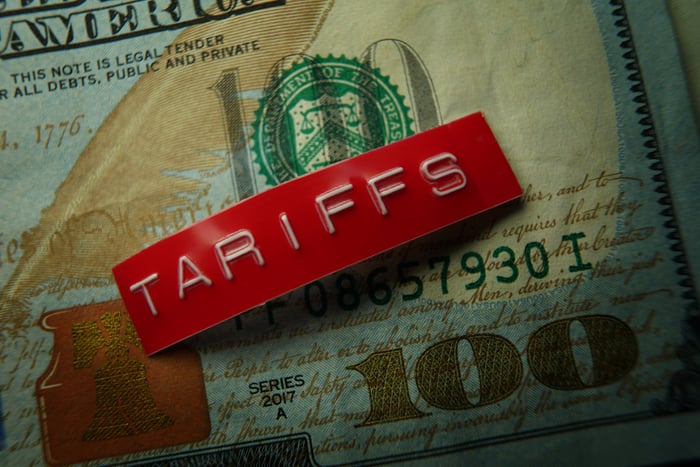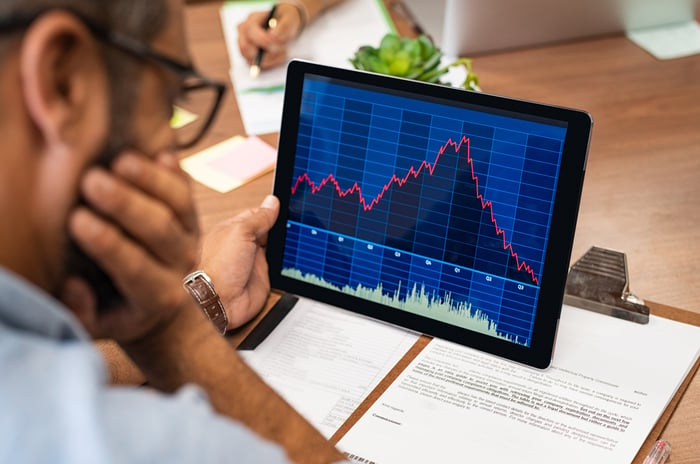“Buckle up and hold on” has been something of a theme for Wall Street over the last two weeks. Ever since President Donald Trump unveiled his “Liberation Day” tariffs, the Dow Jones Industrial Average, S&P 500, and Nasdaq Composite have logged some of their largest single-session point gains and declines since their respective inceptions.
Whereas the “Magnificent Seven” stocks were responsible for leading the broader market higher for more than two years, these highly influential businesses have taken it on the chin during the recent sell-off.
Where to invest $1,000 right now? Our analyst team just revealed what they believe are the 10 best stocks to buy right now. Learn More »
For instance, Wall Street’s artificial intelligence (AI) darling Nvidia (NASDAQ: NVDA) briefly became the world’s largest public company and sported a market cap of nearly $4 trillion during the first week of January. But since reaching its closing high on Jan. 6, it’s shed 26% of its value (as of April 11), and plunged by as much as 36% (as of April 8).

Image source: Getty Images.
Tariffs are a problem, but far from the biggest concern for AI darling Nvidia
Some investors might quick to assign the blame for this weakness on uncertainty tied to President Trump’s tariff announcement.
Although Trump has issued a 90-day pause on higher reciprocal tariffs for most countries, a series of escalating tariffs between the U.S. and China could be problematic. Even though Nvidia doesn’t import from China, the world’s No. 2 economy is one of Nvidia’s core markets by net sales. Retaliation from China could take the form of shunning Nvidia’s AI hardware.
Initially, Trump’s Liberation Day announcement also called for a higher tariff on Taiwan, which is home to world-leading chip fabricator Taiwan Semiconductor Manufacturing (NYSE: TSM). TSMC, as Taiwan Semi is more commonly known, is a key provider of chip-on-wafer-on-substrate packaging technology that incorporates the high-bandwidth memory needed to make AI-accelerated data centers tick. Thankfully, an update this past weekend from the president ensured that chips and chip equipment would be excluded from reciprocal tariffs.
Tariffs, and the uncertainty created by President Trump changing when and what tariffs go into effect, are a problem for Nvidia. However, tariffs are pretty far down the list of things current and prospective Nvidia shareholders should be worried about. Three other factors are far more likely to be responsible for weighing down Nvidia stock.
1. Internal competition
Competition is pretty much a universal problem for publicly traded companies. Even though Nvidia’s Hopper (H100) graphics processing unit (GPU) and successor Blackwell GPU architecture currently account for the lion’s share of GPU market share in high-compute data centers, they’re not impervious to growing competition.
Most investors are probably focused on external direct competitors, such as Advanced Micro Devices (NASDAQ: AMD). AMD continues to develop new generations of its Instinct series AI-accelerating chips, all of which have been notably less-costly than Nvidia’s AI hardware. Businesses that are unwilling to wait in a long queue for access to Nvidia’s AI chips might opt for AMD’s Instinct GPUs.
But there’s a bigger threat for Nvidia than AMD and its peers — a threat that emerges from within.
Many of the largest GPU orders received by Nvidia have come from members of the Magnificent Seven. The problem is that these industry goliaths are also internally developing AI chips and/or solutions of their own to use in their data centers. Even though this internally developed hardware is unlikely to be superior to Nvidia’s in terms of computing speed, it’s considerably cheaper and more readily available (i.e., not backlogged).
Put another way, Nvidia can continue to introduce new AI-GPUs annually and still lose valuable data center real estate to its own top customers. That’s bad news for future orders and Nvidia’s already retracing gross margin.

Image source: Getty Images.
2. History
A second issue that’s more of a worry than tariffs is the possibility of history rhyming, once more, on Wall Street.
For the better part of the last three decades, investors have had a next-big-thing technology or innovation to hold their attention. It’s not uncommon for investors to be drawn in by pie-in-the-sky addressable market figures attached to a potentially game-changing technology or trend.
However, every next-big-thing trend since (and including) the advent of the internet in the mid-1990s has endured the same fate: a bubble-bursting event. Professional and everyday investors consistently overestimate how quickly a new trend or technology will earn widespread adoption and/or gain meaningful utility, which is what leads to lofty expectations not being met.
Though we’ve witnessed aggressive enterprise spending on AI infrastructure, there’s little evidence to suggest that businesses are generating a positive return on these AI investments or have figured out how to optimize their AI solutions. It takes time for all new technologies and trends to mature, and it’s safe to say that artificial intelligence isn’t anywhere close to this point as of yet.
If history were to rhyme and investor expectations are reset, there’s arguably not a public company that would be hit harder than Nvidia.
NVDA PS Ratio data by YCharts. PS Ratio = Price-to-sales ratio.
3. Valuation
The third issue that’s a considerably bigger concern than tariffs for Nvidia is its valuation.
Last summer, Nvidia’s price-to-sales (P/S) ratio peaked at 42.39, which is consistent with the peak P/S ratios of market-leading businesses prior to the dot-com bubble bursting. Even though Nvidia’s P/S ratio has been halved since last summer to 21.06, this is still double the premium assigned to the priciest Mag-7 stocks, relative to their sales.
As alluded earlier, Nvidia’s generally accepted accounting principle (GAAP) gross margin has begun rolling over, as well. Exceptional pricing power for its GPUs, along with AI-GPU scarcity, helped lift its GAAP gross margin to a peak of 78.4% in the fiscal first quarter of 2025 (ended April 28, 2024). However, its GAAP gross margin has fallen in each successive quarter and is forecast to dip to 70.6% (+/- 50 basis points) in the fiscal first quarter of the current year.
Waning AI-GPU scarcity and the company’s own accelerated product replacement cycle could be an ongoing drag on margins. Nvidia’s efforts to bring a new AI-GPU to market annually could lead to rapid depreciation of prior-generation AI-GPUs, as well as lessen the desire by existing customers to upgrade to next-gen hardware.
While the very long-term outlook for artificial intelligence solutions and Nvidia remains bright, Nvidia stock could easily underwhelm in the coming quarters, regardless of what happens on the tariff front.
Should you invest $1,000 in Nvidia right now?
Before you buy stock in Nvidia, consider this:
The Motley Fool Stock Advisor analyst team just identified what they believe are the 10 best stocks for investors to buy now… and Nvidia wasn’t one of them. The 10 stocks that made the cut could produce monster returns in the coming years.
Consider when Netflix made this list on December 17, 2004… if you invested $1,000 at the time of our recommendation, you’d have $495,226!* Or when Nvidia made this list on April 15, 2005… if you invested $1,000 at the time of our recommendation, you’d have $679,900!*
Now, it’s worth noting Stock Advisor’s total average return is 796% — a market-crushing outperformance compared to 155% for the S&P 500. Don’t miss out on the latest top 10 list, available when you join Stock Advisor.
*Stock Advisor returns as of April 14, 2025
Sean Williams has no position in any of the stocks mentioned. The Motley Fool has positions in and recommends Advanced Micro Devices, Nvidia, and Taiwan Semiconductor Manufacturing. The Motley Fool has a disclosure policy.
